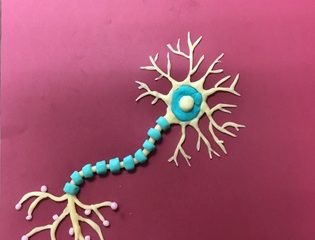Here is what I am reading today:
“Humans live in a world of uncertainty. A shadowy figure on the sidewalk ahead could be a friend or a mugger. By flooring your car’s accelerator, you might beat the train to the intersection, or maybe not. Last week’s leftover kung pao chicken could bring another night of gustatory delight or gut agony.
People’s paltry senses can’t always capture what’s real. Luckily, though, the human brain is pretty good at playing the odds. Thanks to the brain’s intuitive grasp of probabilities, it can handle imperfect information with aplomb.”
“A meticulous study has failed to confirm a connection between chronic fatigue syndrome and a family of viruses that includes XMRV. Nine laboratories — including the two that originally identified a link — could not reliably detect the viruses in blood cells from patients with the mysterious and controversial condition, researchers report online September 22 in Science.”
“Recognizing relations between relations is what analogy is all about. What lies behind this ability? Is it uniquely human? A study carried out by Joël Fagot of the Laboratoire de Psychologie Cognitive (CNRS/Université de Provence) and Roger Thompson of the Franklin & Marshall College (United States) has shown that monkeys are capable of making analogies.”
“Throughout history, science and religion have appeared as being in perpetual conflict, but a new study by Rice University suggests that only a minority of scientists at major research universities see religion and science as requiring distinct boundaries.”
“Here’s a second video, said to be shot from a backyard in Blaine, Washington and claiming to be the satellite, but this one looks to us and to many others like a Chinese lantern. However, the voices on the video are certainly convinced they’re witnessing a fiery reentry”
“Whether you’re cooking a gourmet meal, ordering food from your favorite take-out place or eating on the go, rest assured that what your kids really want during dinnertime is YOU! Family meals are the perfect time to talk to your kids and to listen to what’s on their mind. “




4 Comments
robert_foster · September 27, 2011 at 9:48 am
In response to “monkeys reason through analogy”:
This is a provoking article however, I am highly critical of the findings and I take the following approach to interpreting the conclusions that were reported:
1) Insufficient sample size
“After an intensive learning period covering several thousand tests, 6 baboons” (out of 29) “correctly performed the task, thus demonstrating an ability to resolve analogy problems.”
Scientific researchers agree that environment and situation play a large role on the outcome of a situation. With a statistic as small as 6 out of 29, it seems inaccurate to draw any concrete conclusions regarding the ability of baboons to comprehend analogy separate from possible environmental influence and bias.
2) Unrelated grounds to support the claim
“Furthermore, the researchers suspended the task for nearly one year before proposing it again to the baboons. The animals re-learnt the task much faster than during the initial training, which shows that they remembered the situation.”
I do agree with the finding that the degree to which a participant re-learns a task is correlated to the participants ability to remember that task however, the fact that the baboon remembered the situation does not warrant the claim that the baboon understands what an analogy means.
3) Weak relationship between test and findings
“First of all, the baboons were shown two geometric shapes on a touch screen, for example two squares. After they touched one of these shapes, two other pairs of shapes appeared on the screen, such as: a triangle and a star for the first pair and two identical ovals for the second pair. To successfully complete the exercise and be rewarded, the animal had to touch the pair representing the same relation (of identity or difference) as the initial pair (here, the two ovals).
In other words, the baboon had to detect relations between relations, which is the definition of analogy.”
What can be inferred from this study is that the baboon realized that it must choose a specific option in order to be rewarded. It realized that touching something and then touching something else meant no food and that touching something followed by another choice meant a reward. The drive to eat is a primitive instinct and skews the results of this study. We can not say that the baboon understood that it wouldn’t eat if it didn’t choose the analogy per say, rather it knew that one option delivered food and the other did not.
Also, the ability to recognize figures that share identical characteristics does not prove that analogy can be learned separate from language, which is the claim (separate from the one originally stated in the thesis) that this article attempts to make at the closing of the report. Analogy means more than recognizing similarity, it means understanding the similarity in relations. If a baboon could identify the relationship between food that it eats, and the source in which it comes from, and the food that another neighboring species eats, and the source from which that food was conceived, then a case might be made to imply that the baboon can understand analogy, barring language.
mfitzpatrick · September 29, 2011 at 6:33 pm
I love the article about eating dinner as a family! My family was always to busy to eat together: my sister would have to be at gymnastics at a certain, I would have my extracurricular activities, my youngest brother is autistic and would have therapy sessions during the night time, and my mom and step dad worked late into the night. Not only would eating dinner together allow the family visit and see how everyone is doing, but it would give the family the opportunity to connect and grow closer. Regardless of this fact, I’m still incredibly close with my family but some more quality time with them might have been nice every once in awhile. I can definitely see how a closer family connection would lead to decreased use of drugs or other things.
CCrosson · October 2, 2011 at 8:23 pm
This article immediately popped out to me, because we were discussing the importance of family meals in my family psychology class this past week. We learned that it is important for families to maintain a sense of unity, so that the children know that they are loved, and that their parents or guardians care about them. Eating family meals together every night can be a great way for parents to stay close to their children, and have a greater impact on their choices. I feel like the information I learned in class goes well with this reading, because it makes sense that those dinners and family bonding times can help keep children away from other activities like smoking, drinking, and drugs. I hope that more national movements like this come out, because they have the ability to change lives.
kai zajac · October 23, 2011 at 7:24 pm
The article about family meals really caught my eye. Growing up my family had family dinners almost every night and I really think that is one of the reasons we stayed close as a family. It was a time were everyone could get away from their electronics and work, and really sit down and connect even if it was just small talk. One of my close friends also always had family dinners, and their family is really close. However, the majority of my friends have divorced parents and after reading this article I now remember that none of them had frequent, or any family dinners before or after the divorce. Now this isn’t to say that not eating family dinners together can cause a divorce, it’s just interesting to see how big of an effect it can on most familys. This article reminded me how lucky I was to have parents who put time out to spend some extra time with, and I plan on doing the same when I become a parent.
Comments are closed.